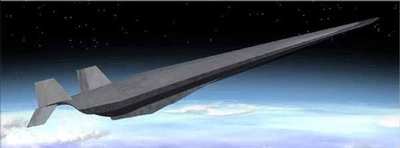Wed, Aug 03, 2005
Mach 7 Tests Planned Next Year
 Pratt & Whitney (P&W) Space
Propulsion recently completed fabrication of a hypersonic Ground
Demonstration Engine (GDE-2) successfully completing a three-phase,
nine-year, $58 million contract with the US Air Force Research
Laboratory (AFRL). The GDE-2 is unique in that it features a
variable geometry inlet and a bolted construction, simulating the
configuration of a reusable access-to-space or global-reach
propulsion system.
Pratt & Whitney (P&W) Space
Propulsion recently completed fabrication of a hypersonic Ground
Demonstration Engine (GDE-2) successfully completing a three-phase,
nine-year, $58 million contract with the US Air Force Research
Laboratory (AFRL). The GDE-2 is unique in that it features a
variable geometry inlet and a bolted construction, simulating the
configuration of a reusable access-to-space or global-reach
propulsion system.
The GDE-2 is undergoing preparations for testing at NASA-Langley
Research Center (LaRC). The first phase of the test program, which
will evaluate the engine's operation and performance at Mach 5
conditions, is scheduled to begin in October.
"GDE-2 is a fully integrated engine that will lead to advances
in hypersonic flight systems," said P&W's Hydrocarbon Scramjet
Engine Technology (HySET) Program Manager Denis Medwick. "This will
be the first time a hydrocarbon-fueled scramjet propulsion system,
which includes a single integrated flow path, fuel control system,
closed-loop thermal management system and a Full Authority Digital
Engine Control, is tested at hypersonic conditions." P&W is
developing hypersonic propulsion systems for strike, global-reach
and access-to-space applications.
The GDE-2 program will examine the functionality of these
integrated technologies during Mach 5 ground testing. A second test
program to evaluate the operation of the engine at Mach 7
conditions is planned for next year. A P&W, US Air Force and
Boeing team will use results from the GDE-2 test program in their
Scramjet Engine Demonstrator - Wave Rider flight demonstration
program scheduled to fly in 2008.

The GDE-2 engine was developed under the HySET program, a
three-phase hypersonic technology program sponsored by the AFRL to
develop and demonstrate a Mach 4-8 hydrocarbon-fueled scramjet
propulsion system.
In July 2003, P&W Space Propulsion teamed with US Air Force
researchers under the HySET program and completed ground testing of
the GDE-1 engine at speeds of Mach 4.5 and Mach 6.5. GDE-1 was the
world's first flight-weight, hydrocarbon-fueled scramjet engine. It
used standard JP-7 fuel to cool both engine hardware and fuel the
engine's combustor.
More News
Aero Linx: Space Medicine Association (SMA) The Space Medicine Association of the Aerospace Medical Association is organized exclusively for charitable, educational, and scientific>[...]
Jamming Denotes emissions that do not mimic Global Navigation Satellite System (GNSS) signals (e.g., GPS and WAAS), but rather interfere with the civil receiver's ability to acquir>[...]
Aero Linx: Warbirds of America The EAA Warbirds of America, a division of the Experimental Aircraft Association in Oshkosh, Wisconsin, is a family of owners, pilots and enthusiasts>[...]
"From New York to Paris, this life-size replica of the Webb Telescope inspired communities around the world and, in doing so, invited friends and families to explore the cosmos tog>[...]
Hold-In-Lieu Of Procedure Turn A hold-in-lieu of procedure turn shall be established over a final or intermediate fix when an approach can be made from a properly aligned holding p>[...]
 ANN's Daily Aero-Linx (04.17.24)
ANN's Daily Aero-Linx (04.17.24) ANN's Daily Aero-Term (04.17.24): Jamming
ANN's Daily Aero-Term (04.17.24): Jamming ANN's Daily Aero-Linx (04.18.24)
ANN's Daily Aero-Linx (04.18.24) Aero-News: Quote of the Day (04.18.24)
Aero-News: Quote of the Day (04.18.24) ANN's Daily Aero-Term (04.18.24): Hold-In-Lieu Of Procedure Turn
ANN's Daily Aero-Term (04.18.24): Hold-In-Lieu Of Procedure Turn




